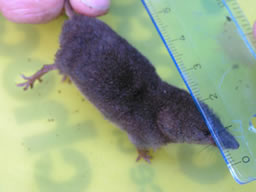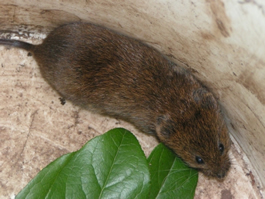


Vagrant Shrew(?) , photo by Hugh Griffith
Creatures Small But Great
by
A rustle - breathing from behind, a sudden pounce, a brief struggle - then silence. The Nature Park is a dangerous place, and you visit at your peril - if you are a small invertebrate such as an earthworm, wood bug or centipede. A fierce predator relentlessly patrols the leaf litter and the underbrush. It is the Vagrant Shrew, the smallest mammal in Richmond, with a body length of about six centimetres.
The Vagrant Shrew is likely the most common of four shrew species found in the Lower Mainland. It is cinnamon brown in summer, charcoal grey in winter, has tiny, weak eyes, very small ears, and a long twitchy nose. To feed their rampaging metabolisms, these animals are active round the clock, all year long. They may eat 150 percent of their own weight in a day.
They frequent in the tunnel-like runs made by voles under logs or in dense grass, which may explain why we are finding them as we trap for voles as part of the Nature Park's Bioinventory. Then comes the fun - measuring them. Sure, you've seen the Australian guy wrestling a croc, or subduing a King Brown Snake. You've never seen him measure a shrew. Krikey! They are moving at 78 rpm, while we are plodding along at 33.3.

Townsend's Vole, photo by Hugh Griffith
Voles are other small, seldom seen mammals abundant in meadows and wooded natural areas. They are rodents, in the same group as lemmings and field mice. Typically they stay under cover, living a somewhat frenetic vegetarian existence while trying to remain undetected by predators such as birds of prey, coyotes, raccoons, and, in winter, Great Blue Herons.
A relatively common species is the Townsend Vole. It is chocolate brown, about thirteen centimetres long with a tail adding another six centimetres. It is a prolific breeder and a major food source for the predators mentioned above. It resembles a number of other vole species, including the much rarer red-backed vole. One of the key ways of distinguishing among species of vole is, again, measuring them. One of the required measurements is of the hind foot. Nobody makes tiny vole-sized versions of those antique-looking devices for human foot-measuring found lying abandoned under benches in shoe stores. There is a steep learning curve in rodent wrangling, in mastering the technique of gathering data from frightened, frantic little animals possessing strong jaws and very sharp teeth, without causing harm to either rodent or handler.
Shrews, voles - in any decently sized woodlot there must be hundreds of these small mammals, doing what they have been doing for millennia. Obiwan Kenobi, after the Death Star had obliterated the small green planet of Alderaan, said, " I felt a great disturbance in the Force...as if millions of voices suddenly cried out in terror and were suddenly silenced. I fear something terrible has happened." I feel somewhat like Obiwan when I see bulldozers spreading pre-load over a space that a week before had been a forest. Assuming nesting season has ended, the birds have flown away. The small things on the ground have not.
Hugh Griffith is a BC zoologist and science writer.
Please cite these pages as:
Author, date, page title. In: Klinkenberg, Brian. (Editor) 2021. E-Fauna BC: Electronic Atlas of the Fauna of British Columbia [www.efauna.bc.ca]. Lab for Advanced Spatial Analysis, Department of Geography, University of British Columbia, Vancouver. [Date Accessed]
© Copyright 2021 E-Fauna BC.